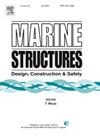Mechanical characterization of bend-twist coupling behavior in composite marine hydro-kinetic turbine blades
IF 5.1
2区 工程技术
Q1 ENGINEERING, CIVIL
引用次数: 0
Abstract
Bend-twist coupling is a phenomenon in some structures whereby bending moments produce not only transverse deflection, but also twist. Recent decades have seen a growing trend toward exploiting this mechanism to advance the performance of structures. This coupling effect can be caused by geometric factors such as eccentric loading, or it can be induced by leveraging the anisotropic nature of fiber-matrix composites. This study focuses on the purposeful use of unbalanced layups in laminated fiber-reinforced polymer spars to tailor bend-twist coupling behavior.
An especially promising application of bend-twist coupled composite structures is their potential use in marine energy turbines. Recent efforts have shown that bend-twist coupling can be used to reduce loading on turbine blades in overload conditions, thereby improving their robustness, without significantly reducing power generation under normal operating conditions. This work robustly characterizes, using both experimental and numerical methods, the relationship between the effective fiber angle (a design parameter) and the: (i) degree of bend-twist coupling, (ii) bending stiffness, and (iii) natural frequencies (system properties) of laminated composite blades. The outcomes of this work will help designers choose the optimal fiber angles for specific applications and will serve as a strong benchmark for the validation of computational models.
船用复合水动力涡轮叶片弯扭耦合性能的力学表征
弯扭耦合是某些结构中的一种现象,其中弯矩不仅产生横向挠度,而且产生扭转。近几十年来,人们越来越倾向于利用这种机制来提高结构的性能。这种耦合效应可能是由偏心载荷等几何因素引起的,也可能是利用纤维基复合材料的各向异性引起的。本研究的重点是在层压纤维增强聚合物梁中有目的地使用不平衡层来定制弯曲-扭转耦合行为。弯扭耦合复合结构的一个特别有前途的应用是它们在海洋能源涡轮机中的潜在应用。最近的研究表明,弯扭耦合可以用来减少涡轮叶片在过载条件下的负荷,从而提高其稳健性,而不会显著减少正常工作条件下的发电量。这项工作通过实验和数值方法强有力地描述了有效纤维角(一个设计参数)与层压复合材料叶片的弯扭耦合程度、弯曲刚度和固有频率(系统特性)之间的关系。这项工作的结果将有助于设计人员为特定应用选择最佳的纤维角度,并将作为验证计算模型的有力基准。
本文章由计算机程序翻译,如有差异,请以英文原文为准。
求助全文
约1分钟内获得全文
求助全文
来源期刊

Marine Structures
工程技术-工程:海洋
CiteScore
8.70
自引率
7.70%
发文量
157
审稿时长
6.4 months
期刊介绍:
This journal aims to provide a medium for presentation and discussion of the latest developments in research, design, fabrication and in-service experience relating to marine structures, i.e., all structures of steel, concrete, light alloy or composite construction having an interface with the sea, including ships, fixed and mobile offshore platforms, submarine and submersibles, pipelines, subsea systems for shallow and deep ocean operations and coastal structures such as piers.
 求助内容:
求助内容: 应助结果提醒方式:
应助结果提醒方式:


